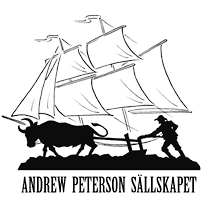Andrew (Anders) was, just like Karl Oskar, an eldest son who worked on stony fields on his Father’s homestead for four years before he, when he’d reached his thirties, emigrated to North America. This is, all of it, consistent with Karl Oskar’s experiences in the novel. Andrew’s exit permit and certificate (church school grades) from the parish Priest and Provost was issued for him in print and handwriting on the 5th of April, 1850, and his arrival to Burlington was the 30th of July 1850.
Karl Oskar got his exit permit 28 of March 1850, and arrived to Stillwater on the 31st of July, 1850. When you look at Andrew’s and the fictional character Karl Oskar’s lives as settlers in Minnesota, it is easy to see not only similarities, but oftentimes they experience exactly the same things. The similarities between the hardships and adventures – the knowledge, skills and abilities they possessed, as well as how Karl Oskar’s family members, friends and travel companions in the novels resemble the people we meet in Andrew’s diary so much – can’t be a coincidence. Their lives continue to mirror each other right up until the day that they die, 40 years after having settled in Minnesota.
Karl Oskar’s party of emigrants from Ljuder was a group consisting of 16 individuals. Nine adults and seven children. Andrew’s party of emigrants from Västra Ryd was also a group of 16 individuals. Ten adults and six children.
The unmarried shoemakers’ daughter, Kristina Jansdotter, who was three years younger than Andrew – and who lived in Sjöstugan 1,5 km from Andrew’s farm in Sjöarp – may have inspired Moberg to give Karl Oskar’s wife the name ‘Kristina Johansdotter’. Another source of insipiration for the name might have been Andrew’s sister Kristina who emigrated two years after Andrew and became Andrew’s neighbour in Minnesota. Andrew spells her name “Chrestina” – which is precisely how Karl Oskar pronounces his wife Kristina’s name.
Andrew’s sister Gustafva, who emigrated together with Andrew, was eleven years younger than him. The age-gap between Karl Oskar and his younger brother Robert is the same, just about. Andrew’s younger brother Carl (who emigrated two years after Andrew) lived a life in the USA that resembles the fictional character Robert’s life very much. They both participated in the Goldrush, amongst a wealth of other things, see below, or the chapter “ Brother Carl; the model for Robert” for a more in depth description.
Andrew’s neigbors’ names in Minnesota correspond with the names of many characters in Karl Oskar’s circle of friends. There is ‘Jonas Petter’, ‘the German Fisher’ and ‘Per Danjel’. The closest neighbours to the west of Andrew’s farm were both called ‘Swenson’. There is also his sister ‘Kristina’ whose name Andrew spells “Chrestina” – the same way Karl Oskar pronounces his wife’s name. There is Ulrika, who is married to the Baptist pastor. There is the exiled preacher F.O. Nilsson, who was a neighgbour of Andrews’, who reminds one of Kristina’s uncle, Danjel Andreasson, in the novels. Danjel Andreasson was also forced into exile because of his religious beliefs – and was a neighbour of Karl Oskar and Kristina.
Andrew’s wife Elsa and Karl Oskar’s wife Kristina both gave birth to nine children. These five names are the same in Andrews and Karl Oskars families: Anna, Charles, Frank, John and Oskar
Both their daughters who were named ‘Anna’ died young – and – in both cases this had a great impact on the parents. On the 19th of September 1899, Andrew made the following entry in his diary: “Today we are deep in sorrow, our beloved Daughter Anna Isabella, Died today 15 minutes past twelwe o’clock —- she was always kind, quiet, and forebearing, and thus the Missing of her, and the Sorrow is heartgripping for us all”.
Excerpt from “The Emigrants”: “In the early hours of the morning the girl (Anna) died after much suffering and pain. Those who spoke to Karl Oskar in the days that followed had to wait for an answer”.
Andrews youngest brother Carl emigrated in 1852 (only 15 years old at the time) accompanied by his sister “Krestina”, to Andrew’s settling place. A couple of years later, Carl traveled west, during the Gold rush. Carl became part owner of a small mine in New Mexico, he died of alcohol-poisoning at the ‘Court Hall Saloon’ in Denver, Colorado. He was 40 years old and unmarried. Despite the many letters that were sent to both district courts and to people of influence in Colorado and New Mexico – Andrew and his siblings never received the inheritance from Carl that they were entitled to. You could say that the golden dream turned to dust. On two occassions Andrew received cheques adressed to Andrew Peterson that came from his brother Carl. Both these times Andrew experienced much difficulty with redeeming the cheques at the bank. Andrew’s brother Carl’s life and fate is very similar to that of Karl Oskar’s brother Robert’s in the novels.
Several other authentic public persons, and some who were linked to Carver Country in some way or other – also appear in Andrew’s diaries and are mentioned in Mobergs emigrant novels. Amongst others, there is the priest ‘Norelius’ and the preacher and pastor ‘F.O Nilsson’.
You can find more interesting similarities if you read our pamphlet: Andrew Peterson, the model for Karl Oskar – 100 similarities
Copyright Andrew Petersonsällskapet
